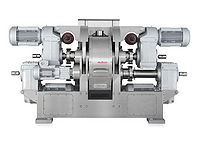Roller Compactors
Roller Compactors are used to force fine powders between two counter rotating rolls and presses the raw material into a solid compact or sheet, so called flakes. Finally these flakes are then reduced in size to the desired grain size.
Processes
At the beginning of the process the powdery and fine crystalline materials are fed into the compactor hopper. Here, an integrated screw feeder with stirrer secures an even flow of material. Due to it’s design, the screw has a pre-compacting and de-aerating effect on the raw material. The vertical screw feeder feeds the product into the nip area of the compacting rolls. The adjustable speed of the screw directly influences the roller gap and therefore the compaction capacity of the roller compactor. The roller compactor then compacts the material into flakes. The feed characteristics of the product are influenced by the surface of the rolls. The retention time of the product within the compaction area is determined by the adjustable speed of the rolls. The necessary compaction pressure is transmitted to the rolls via the hydraulic system. It is infinitely variable within a range. The hydraulic unit keeps the set roll pressure constant, in order to guarantee a homogeneous flake, whilst scrapers keep the rolls clean.
The flake then falls into one or several subsequent rotor sieving mills after compaction. Incoming flakes are reduced in size as carefully as possible in order to prevent the generation of fines. The selected sieve defines the final granule grain size. An integrated screening machine to separate fines is available on request.
Common Areas of Applications
Roller compactors are used in the chemical and natural resources industries in the production of organic and inorganic raw materials such as:
- Pigments
- Battery substance
- Salt (de-icing salt, salt for water softening)
- Fertilizers
- Silicid acid (for the further processing of tyres)
- Animal feeds
- Additives (softening agents, for example)
Advantages
Economical
Dispenses of intermediate processes such as wetting, mixing and drying as compared to wet granulation systems.
Variable
Grain size, bulk density, flowability and solubility of processed granules are adjustable. Blends or Mixtures will be homogenised.
Environmentally friendly
Granulated materials reduce the packaging size, minimize dust burden, avoid cross contaminations and product loss.
Space saving and high-grade
All machines feature a compact design and are manufactured of high grade stainless steel.
Low investment costs
Modular design, a large variety of models and comprehensive standard variations ensure a considerable reduction in costs. Each machine is tailored to the individual application.
Video
